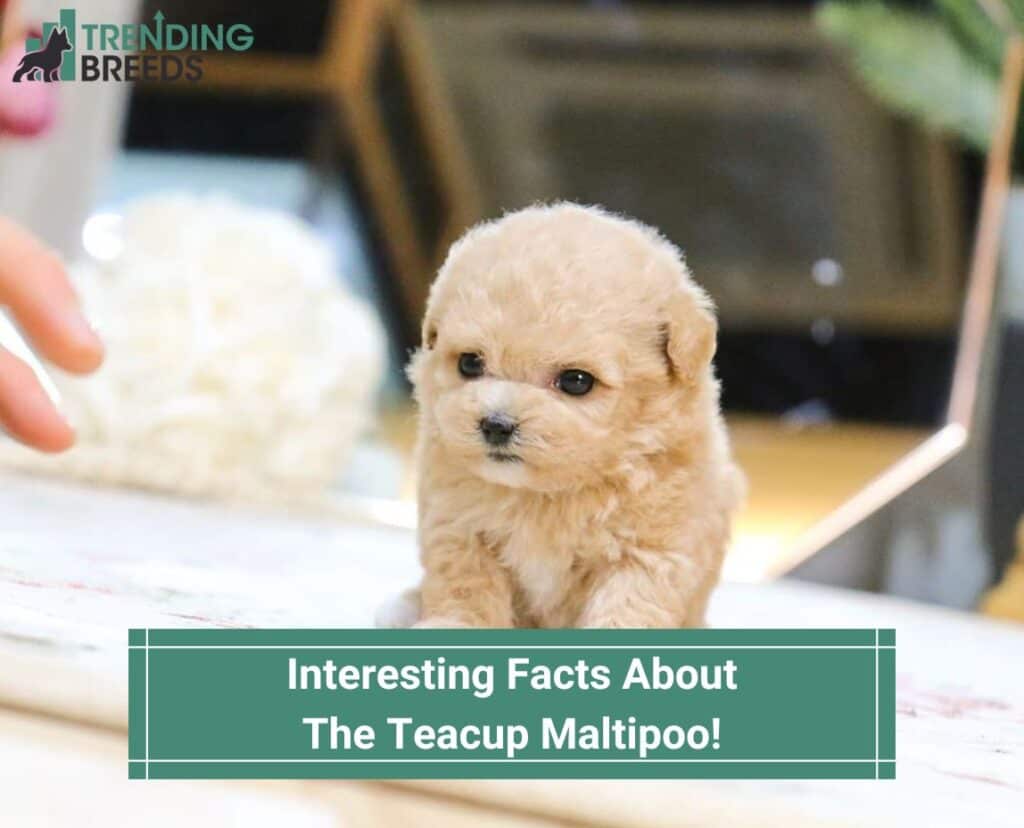
Maltipoos, the result of a mix of Maltese and a Poodle, are one of the most promising results of these breeding experiments.
These tiny balls of curly fur are not only the cutest dogs around due to their furry, and happy presence; they make wonderful companions for humans. Smarter than most dogs, they differ from canines in many ways.
Other articles you would like: What Is A Maltipoos Lifespan? and Are Cavapoos Hypoallergenic?
Table of Contents
Facts About The Teacup Maltipoo

This dog crosses a Maltese with a Toy or Miniature Poodle to create a cute, affectionate, smart, and a athletic mix. Small, charming companion dogs, Maltipoos are also called Miniature Maltese Poodles.
Maltipoos weigh less than 20 pounds at full maturity, so they are ideal for apartments. Generally, the coat color is white or cream, and there is a low level of shedding.
They are very friendly and smart, and many people prefer them due to their small size and easy-going temperament. There are some interesting facts about these little dogs that you may not know.
1. Aristotle Was a Fan

Ancient Greek societies were very fond of the Maltese who were originally from Malta. Melitaei Catelli, a relative of the toy Maltese dog, was first mentioned by Greek philosopher Aristotle.
It dates back to 370 BC. Some historians identify an early Maltese breed type described in Roman poetry as a “small white dog”.
There is no exact information about the origin of the Maltese dog. However, it is thought to be related to Tibetan Terriers or Swiss Spitz dogs.
Bichons and Maltese are completely different dog breed types, which means that the Maltese cannot be classified as a Bichon.
2. They Are Very Small
Due to its small size, Malteses are often referred to as a teacup Maltese. As a small Maltese dog breed, the teacup is recognized as a small breed by the American Kennel Club, not as a separate breed.
Teacup Malteses may thus be registered with the Kennel Club under the Maltese breed standard. Depending on the breed standard, you may not be able to register a teacup-sized dog at all.
When breeders tried to make this small dog even smaller in the 17th and 18th centuries, they developed the mini Maltese variant.
A Miniature Poodle and Spaniel line was crossed with Maltese dog breeds. At one time, the Maltese breed was thought to include up to eight varieties of dogs.
Since 1964, no changes have been made to the breed standard that has evolved over time.
3. The Breed Has Many Different Names

Within the last decade, Maltese teacups have been called many names. There have been many names given to the breed since it first appeared in Malta. The following are examples, but they are not exhaustive:
- Ye Ancient Dogge of Malta
- Melitae Dog
- Roman Ladies Dog
- Maltese Lion Dog
- Spaniel Gentle
- Maltese Terrier
- Melitaei Catelli
There are many names given to Maltese dogs over the years. Despite their differences, as you can see from the list, they share one characteristic in common: they are popular companion animals known for their warmth, friendliness, and companionship.
4. They Were a Preferred Breed Of English Royalty
As Mary Queen of Scots and Queen Elizabeth I both owned toy Malteses, they have been seen on the laps of royalty in England. It is believed that the Maltese is related to the Spitz breed of dog.
There were many Maltese dogs owned by British royalty, including Queen Elizabeth I.
Breeders nearly extinguished the breed by attempting to make it the size of a squirrel.
The Maltese breed, however, was saved from extinction by breeders mixing Poodles, Miniature Spaniels, and East Asian dogs with the existing stock. By the time the English arrived in the United States, the Maltese had already arrived.
In Europe, Miniature Schnauzers were originally used as ratters and guard dogs. In Germany, they can trace his roots back to the mid-nineteenth century.
Smaller terriers were bred with the Standard Schnauzer in order to produce a smaller dog. It was named Findel in 1888 that the earliest mini-Schnauzer was recorded.
A lot of hardships were faced by the breed during the two Great Wars. In the post-war years, however, the breed regained popularity.
Schnauzers are a part of the terrier family in the American Kennel Club, but no information is available about how they came to the country.
5. They Only Come In White

There is nothing cuter than a Teacup Maltese dog breed. A typical adult weighs 4 or 5 pounds and stands about 8 inches tall. There is no massive difference between the size of male and female Maltese Teacups.
In accordance with breed standards, Maltese dogs may only be white. The color black, as well as any other color, including bicolored and tricolored, has had a negative connotation since 1913.
They are easily recognized because of their rounded faces, black noses, and black eyes, commonly described as having an intelligent expression.
When a Maltese bitch comes into season, or if they don’t receive enough light, their black noses can turn pink. In addition to being hypoallergenic, this breed is also excellent for individuals with allergies.
It is more than likely that your Maltipoo will also suffer from epiphora or excessive tear production since both Poodles and Maltese breeds are predisposed to the condition.
Maltipoos with lighter-colored fur tend to show it more, but it’s not dangerous. It is perfectly harmless as long as the staining doesn’t emit an odor and doesn’t look swollen.
It is important to have your eyes checked by a veterinarian and to have them cleaned regularly if you want to be safe.
6. They Can’t Climb Stairs
This breed of Maltese is extremely fragile due to its teacup-sized size. When a small dog such as a Maltese gets under your feet, you will easily miss them and an accident may occur.
The enthusiasm they have for being by your side is contagious, but you should take great care when interacting with them.
A Maltese Teacup, with its small size, can also be a challenge to walk on stairs, which can lead to even bigger accidents. Teacup Maltese are therefore most commonly found in houses with all floors, like flats and bungalows.
Even though dogs like these are playful and loving, it is important to supervise young children when they play. Teacup Maltese are small dogs, which means they can break easily, and this breed is quite boisterous.
Therefore, Teacup Maltese must be looked after properly, and if interactions with children are important, it is equally essential that children know how to play with the dog gently.
7. They Can Be Pricey

It takes two very tiny Maltese dogs to breed together to produce a Teacup Maltese. A Maltese dog of standard size can only bear up to three puppies safely, so most Teacup Maltese puppy litters will produce one or two puppies.
It is not uncommon for Teacup Maltese mothers to have to give birth via cesarean section when they have just one puppy. It is imperative for mothers to take good care of their bodies due to the stress they are under.
Teacup Maltese puppies cost between $750 and $2,000 USD due to these extra precautions. In addition to their high price tag, this breed is popular with backyard breeders and puppy mills because of the high demand.
There are people like this who are more concerned with making a quick buck than caring for their dogs’ welfare.
8. They Often Suffer From Low Blood Sugar
Health problems are common among miniature Maltese. Hypoglycemia (low blood sugar) is the most common problem affecting this breed, it can lead to a number of health complications, including seizures.
Teacup Maltese dogs need to maintain their blood glucose levels by eating twice a day or more to help manage this condition.
Dental problems are also common among Teacup Maltese dogs. Having regular dental visits and brushing their pets’ teeth should be a part of the owners’ routine.
As a result of their smaller size, teacup Maltese dogs are also susceptible to respiratory, heart, and liver problems. When considering purchasing a Maltese puppy, prospective owners should consider that vet bills will be a bit higher than usual.
The Maltese Teacup has been bred to eat only the best of the best as a result of their heritage in the palaces of royalty. A diet containing approximately 20% protein is recommended for teacup Maltese.
It is better to feed a Teacup Maltese puppy small quantities of high-quality protein rather than lots of low-quality protein, particularly since quality is more important than quantity.
Keeping your Maltese puppy’s coat shiny requires about 5%-10% fats and oils.
It is important to feed this dog breed little and often due to their tendency to develop low blood sugar levels. A high-quality, grain-free diet is preferred by the Maltese Teacup most of the time.
9. They Have a Long Life Expectancy

There is an average lifespan of 12 to 15 years for a Teacup Maltese. All dog owners are concerned about the comparatively short life expectancy of the Teacup Maltese, which is 12-15 years.
There are Maltese that live older than 15 years, and even older than 17 years before they die from natural causes. The average lifespan of a woman is longer than that of a man.
In contrast to other dogs, Maltipoos don’t lose their hyperactive, spunky character as they grow older. It’s just like having a puppy around when you have a Maltipoo.
They always keep their happy, puppy mood and tiny appearance. It is vital that you feed your Maltese a balanced diet so that they are active and healthy.
It is possible for a Maltese who is obese or underweight to live less than their potential life expectancy.
The greater the weight of your dog, the greater the probability of it developing any other health issue that could lead to its death.
It is possible for your Maltese to get heart disease if it is overweight, which in turn can cause breathing problems that could cause her system to collapse if left untreated.
10. They Are Very Smart
The assumption that small breed dogs have lower intelligence is sometimes true, and in many cases (but not all) they do, usually because of poor breeding). A Maltipoo, however, is a more intelligent pup than a standard pocket pup.
In most cases, poodles supply at least half of the genes, and their crossbreeds inherit their intelligence.
Information is retained well and commands are learned quickly. They are also easy to potty train compared to other small breeds. The doggy version of a home run! They are beautiful, intelligent, and quirky – they’re the perfect combination!
If you have a Maltese or if you are considering adding one to your family, you may be interested in knowing as much about the breed as possible.
These little dogs are packed with personality and there’s a lot that many people don’t know about them. These are just a few of the interesting things about Maltese.
You may find even more when you bring one into your home.
Before you decide to adopt any breed of dog, it’s important to do your research so you can learn as much as possible about the breed and ensure you are ready to take on the responsibility of this type of dog.
You will need to be able to meet all its needs to ensure it has a happy and long life.
You will also like:
For more information about the teacup Maltipoo breed, check out the video below:




